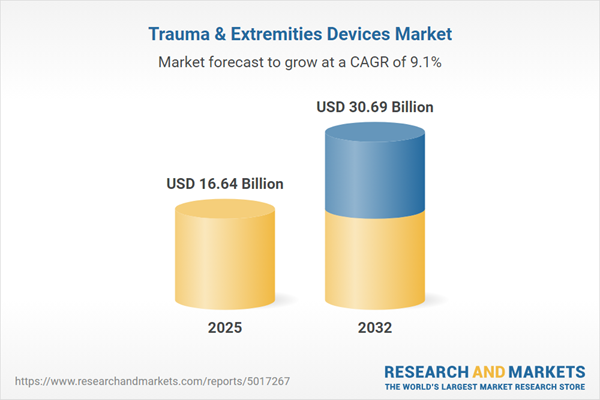Speak directly to the analyst to clarify any post sales queries you may have.
Senior decision-makers navigating the trauma and extremities devices market face mounting complexities—including technical advances, procurement challenges, and shifting risk. Staying ahead now requires forward-thinking strategies for operational agility and market resilience.
Market Snapshot: Trauma & Extremities Devices Market Overview
The trauma and extremities devices market is valued at USD 15.26 billion in 2024, projected to increase to USD 16.64 billion by 2025 and reach USD 30.69 billion by 2032, with a CAGR of 9.13%. Market growth is primarily driven by the integration of advanced fixation devices, greater adoption of biologic solutions, and heightened focus on outpatient care models. In response, industry stakeholders are modernizing supply chains, optimizing scalable production, and refining reimbursement mechanisms to enhance operational efficiency and market accessibility while keeping pace with changing patterns in global healthcare delivery.
Scope & Segmentation in the Trauma and Extremities Devices Market
This report delivers strategic direction on core segments, procurement pathways, and adoption drivers vital for senior leaders shaping supply chain and purchasing frameworks in the trauma and extremities devices sector. Rigorous segmentation helps benchmark peer practices and project future shifts.
- Product Types: Targets bone graft substitutes—including autografts, allografts, demineralized matrices, and synthetics—plus a full spectrum of internal and external fixation systems. Today’s biomaterial innovations and refined surgical techniques broaden provider options for complex injuries and patient requirements.
- Distribution Channels: Reviews direct procurement channels from hospitals, manufacturer collaborations, third-party distributors, and expanding digital procurement. Digitalization is reducing transactional bottlenecks and supporting broader geographic reach for devices and spares.
- Applications: Explores device roles across acute trauma and chronic extremity conditions—spanning the foot, ankle, leg, humerus, and wrist—where matched device functionality with clinical care protocols remains a top priority.
- End Users: Evaluates ambulatory surgery centers, hospitals, and integrated clinical teams as primary consumers. Sourcing decisions are increasingly informed by coordinated and outcome-driven approaches.
- Regional Coverage: Assesses established and emerging markets across the Americas, Europe, Middle East & Africa, and Asia-Pacific. Understanding local procurement regulations and supplier ecosystems is essential for effective market entry and compliance.
- Companies Analyzed: Includes market evaluation for DePuy Synthes, Stryker Corporation, Zimmer Biomet, Smith & Nephew, Arthrex, Enovis, MicroPort Scientific, Medacta, Integra LifeSciences, and CONMED Corporation. The report examines their innovation initiatives and evolving market positions.
Key Takeaways for Senior Decision-Makers
- Advancements in trauma and extremities device technology prompt procurement teams to reexamine purchasing criteria, factoring in clinical appropriateness and long-term value beyond upfront costs.
- The expansion of outpatient and ambulatory care prompts the need for flexible, modular device portfolios, reinforcing the importance of close vendor partnerships for rapid adaptation.
- Enhanced distributor networks and digital procurement methods increase supply chain resilience, helping organizations respond more effectively to logistical or geographic disruptions.
- Procurement strategies aligned with clinical workflows can streamline operations, supporting reliable patient outcomes across acute and elective procedures.
- Actively monitoring regulatory and reimbursement developments allows teams to maintain agility and reduce exposure to shifting industry requirements.
- Establishing and managing comprehensive supplier contracts enables organizations to buffer the impact of regulatory or logistical uncertainty.
Tariff Impact and Supply Chain Strategies
Forthcoming tariff changes in 2025 are impacting the structure of supply chains for both device manufacturers and healthcare providers. As organizations increasingly shift toward nearshore manufacturing, transparency and consistency improve. Leadership is now prioritizing renegotiation of supplier contracts, refining procurement methodologies, and fostering communication with partners. These actions support better cost control and strengthen device availability, even during regional disruptions or variable logistical challenges.
Methodology & Data Sources
This report is based on interviews with leading orthopedic clinicians, supply chain managers, and executives from top global device manufacturers. Insights were cross-referenced with clinical registry data and subject to independent expert review, ensuring actionable intelligence that addresses the procurement and supply chain priorities of industry leaders.
Why This Report Matters
- Empowers leadership to align procurement and distribution with evolving clinical standards and supplier environments, driving efficiency across procurement teams.
- Clarifies critical factors in contract negotiations, reimbursement diversities, and supplier relationships, helping organizations build supply chains that adapt to a volatile market.
- Enables proactive management of regulatory and operational risks for sustained flexibility as the broader healthcare technology landscape advances.
Conclusion
Sustained success in the trauma and extremities devices market depends on strategic technology investments, sound supplier governance, and adaptable procurement. Organizations prepared with reliable insights are better positioned to anticipate trends and reinforce their competitive standing.
Additional Product Information:
- Purchase of this report includes 1 year online access with quarterly updates.
- This report can be updated on request. Please contact our Customer Experience team using the Ask a Question widget on our website.
Table of Contents
3. Executive Summary
4. Market Overview
7. Cumulative Impact of Artificial Intelligence 2025
Companies Mentioned
The companies profiled in this Trauma & Extremities Devices market report include:- DePuy Synthes, Inc.
- Stryker Corporation
- Zimmer Biomet Holdings, Inc.
- Smith & Nephew PLC
- Arthrex, Inc.
- Enovis Corporation
- MicroPort Scientific Corporation
- Medacta International SA
- Integra LifeSciences Holdings Corporation
- CONMED Corporation
Table Information
| Report Attribute | Details |
|---|---|
| No. of Pages | 197 |
| Published | November 2025 |
| Forecast Period | 2025 - 2032 |
| Estimated Market Value ( USD | $ 16.64 Billion |
| Forecasted Market Value ( USD | $ 30.69 Billion |
| Compound Annual Growth Rate | 9.1% |
| Regions Covered | Global |
| No. of Companies Mentioned | 11 |









